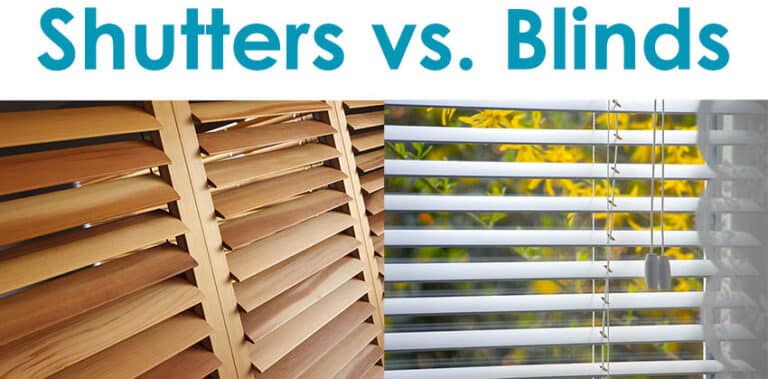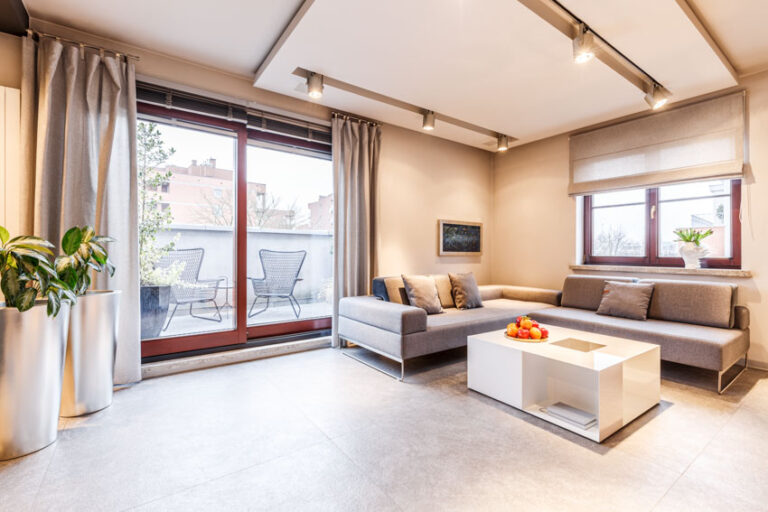Laminate vs Vinyl Flooring (Differences – Pros & Cons)

Laminate flooring and vinyl flooring are two great choices when it comes to affordable flooring. Between the sizes, color choices, maintenance, and environmental concerns, there are many considerations determining whether vinyl or laminate flooring should be used for an interior design. Determining the different sorts of qualities you desire from the flooring and then comparing the two side by side is the best. These two flooring types are actually pretty similar, though there are a few key differences. If laminate or vinyl are not suitable for the needs of the space, there are other selections, such as solid hardwood flooring, which is compared at the very end, and contains a few more differences, especially in price.
Difference Between Vinyl and Laminate Flooring
Laminate and vinyl flooring are two types of flooring that can be selected for almost any space. Living rooms, bathrooms, kitchens, or bedrooms in homes, or even in commercial spaces, can all become home to vinyl or laminate flooring. Below are detailed descriptions of each of the two items and their key differences.
Laminate Plank Flooring
Laminate flooring is a synthetic product, but does contain some woods in the middle. Laminate is made from multiple layers of this product that are then fused together through lamination (which is where it gets its name). The lamination process includes heat, pressure, welding and gluing. This process varies based on the materials being used. The simple idea of laminating paper can be thought of when thinking about laminating flooring.
Laminate flooring usually contains an inner core of resin and fiber boards as the ‘filler’ material. The flooring is then laminated one, or likely more times. This adds strength, stability, insulation and improves the appearance of the flooring.
There are typically four layers when it comes to laminate flooring: Back layer, which protects against moisture, the core later, which is the inner core mentioned above, the design layer, which is a colored photo that is placed on the planks, and finally the wear layer, which is what gets laminated together, that protects against staining, fading and burning.
Vinyl Flooring
Vinyl is a resin that is made by polymerizing vinyl compounds. In simpler terms, vinyl flooring is also a synthetic product, which why laminate and vinyl flooring are often compared. Vinyl, though, is completely synthetic.
Vinyl flooring can come in sheets, tiles or planks. Sheet vinyl typically comes 6 feet to 12 feet wide, this is good for water resistance and is easier to install due to the lower amount of seams that need to be made.
Vinyl tiles are typically 9 inches by 9 inches or 12 inches by 12 inches. The vinyl tiles tend to mimic that of ceramic tiles which is the allure. Older vinyl tiles need to be removed and replaced very carefully as they often contained asbestos materials.
Vinyl is great when it comes to durability to foot traffic, but is not as durable when heavy loads or sharp objects. Unfortunately vinyl can give off some off gas VOCs (Volatile Organic Compounds) after it has been installed. These have chemicals that can turn to vapor at room temperature.
Key differences:
– Vinyl can come in sheets, tiles or planks, laminate is typically only planks.
– Laminate is more comfortable to walk on, the thickness and warmth are better for underfoot.
– Vinyl has better moisture resistance, therefore would be a better selection for bathrooms or kitchens.
– Laminate has a higher resale value.
– Laminate typically has a more natural appearance compared to vinyl. Read more about wood look tile flooring here.
Laminate vs Vinyl Flooring Pros & Cons
Vinyl Pros:
Durability – Vinyl can be an extremely it taken care of correctly. The thicker the wear layers on the vinyl flooring, the more durable the flooring will be.
Waterproof – Vinyl is a waterproof flooring, which is great for kitchens and bathrooms. (For more ideas read about waterproof wood flooring for bathrooms on this page.)
Installation – Vinyl flooring is relatively easy to install, and can often be done as a do it yourself. These are even available in easy stick pieces! To install all you need to do it: level the underlayment, trim any pieces (with a utility knife, no saws needed), remove the backing, lay the planks, and then use a roller to help solidify the bond to the underlayment.
Price – The price of vinyl flooring is super affordable! Typically vinyl is between $2 and $ per square foot. Sheet vinyl is less expensive than luxury vinyl planks, and each brand will vary, but that being said, vinyl is extremely cost effective across all boards, including install, and maintenance.
Vinyl Cons:
Removal – Removing vinyl flooring is pretty difficult. This can be done, but there is a lot of ripping and scraping that would need to be done. Using scraping tools as well as soapy water can help remove the stubborn pieces of glue stuck to the underlayment.
Maintenance – Vinyl flooring can be difficult to keep clean, there are a lot of precautions to follow. For instance, using abrasive rags or scrubbers should be avoided as it will tear up the flooring.
Using ammonia, waxes and other solvents can also dull and damage the vinyl flooring. Alternatively one should use a dry mop as well as a vinegar and water mixture to clean the floors.
Quality – The quality of the vinyl planks can vastly differ from product to product, and that can be difficult for consumers when trying to pick out a product to use.
Knowing the thickness is super important when thinking about the quality of vinyl planks. Thicknesses run from 2 mm to 8 or more mm thick. The thicker the pieces, the more durable the flooring.
Laminate Pros:
Visual Appearance & Selection – Laminate flooring can be made in virtually any color or pattern imaginable. Since laminate flooring is made by including a photo or image of something laminated onto the pieces, you can print pretty much anything on it.
Typically one selects a wood look, or a stone look as those are most aesthetically appealing. Alternatively in some places there are options to add custom finishes on these.
Price – Laminate flooring is an affordable selection, if chosen correctly, while there are some more expensive pieces, there are plenty to choose from for a budget friendly project. Laminate can be anywhere from $1 per square foot to about $5 per square foot.
Installation – Installing laminate flooring is pretty easy, and you can cut costs by doing it yourself! The laminate is created as a floating floor, which means there is no glue; instead, tongue and groove or snap and lock methods are used to join the flooring together.
Heat-resistant – Laminate flooring has heat-resistant qualities, making it one of the few materials that can be installed over radiant heating systems. This gives the flooring a warm feeling and is great for bathrooms and bedrooms in the winter, as you can turn the temperature up a little bit to keep your feet warm.
Laminate Cons:
Refinishing – Laminate flooring cannot be refinished. That means you get one shot for the color choices and wearing. When the laminate is outdated or worn, it has to be completely taken up, and something new needs to be put down. Luckily, it is not ridiculously expensive, so can be easily switched out.
Quality – The quality of laminate flooring, similar to that of vinyl flooring, can vastly differ from product to product. This creates difficulty among consumers when trying to pick out a product to use.
Knowing the AC (Abrasion Criteria) is super important when thinking about the quality of laminate flooring. The options are as listed below:
AC1 – used for low residential spaces, such as bathrooms or closets
AC2 – used for general residential spaces, such as living rooms and kitchens
AC3 – used for heavy residential spaces, such as bnbs or sorority/fraternity homes
AC4 – used for normal commercial spaces, such as offices or smaller businesses
AC5 – used for heavy commercial spaces, such as healthcare or stores
The prices typically go up with the AC ratings, as does the durability. Making sure you know what you want is going to help make sure you get the right rating and quality of flooring for the right price.
Vinyl Plank Flooring vs Laminate
Durability: Vinyl has high durability and typically can last 15 or more years. Adding more layers of urethane can extend that even further. The thickness of the wear layers are going to help determine the durability that each type of flooring has.
Laminate also has high durability, lasting from 10 to 20 years depending on quality. Laminate has multiple types of flooring you can get, each with a different abrasion criteria. Above, there is a list of each category and what they should be used for.
Maintenance: Vinyl usually only needs standard sweeping and standard mopping supplies. Unfortunately it cannot be sanded or repaired, the entire plank must be removed and replaced. In most situations, though, there is not much that will happen to destroy the flooring in a normal use residential setting.
Laminate also only needs standard sweeping and standard mopping supplies. It cannot withstand any standing water or extreme impacts though. When mopping is needed, using a mop is best, any standing water can sneak into the edges and get into the wood core. Laminate cannot be refinished, but the wear layer can be replaced.
Which is Better, Vinyl or Laminate Tile Flooring
For high traffic areas: A high wear layer vinyl flooring will be softer underfoot and durable over time.
For wet areas: use vinyl flooring, as it does not absorb water.
For cleaning: Vinyl flooring, as it does can repel water, unlike laminate, which absorbs water.
For environmental impact: Laminate flooring, as laminate contains a natural center unlike vinyl.
Vinyl vs Laminate Flooring with Pets
Both of these materials are pet-friendly! That being said, some pets can damage these flooring, but they are much less susceptible than other flooring selections, particularly wood flooring. Leaving pet urine on laminate or vinyl can damage the flooring, but there is a little bit of time to clean it up before that happens.
Cleaning up hair and pet dander is easier on vinyl and laminate flooring than with, say, carpeting. Vinyl and laminate can also be scratched by claws, but are more likely to recover than wood flooring.
Vinyl vs Wood Flooring vs Laminate
Adding wood flooring to the mix adds a lot of characteristics to the running.
Materials: Hardwood is 100% complete solid wood. Laminate is partially wood, and vinyl is 0% wood! Due to these materials wood flooring and laminate flooring should not be in wet areas or cleaned with standing water. Vinyl on the other had can be mopped regularly if needed.
Durability/ lifespan: While laminate and vinyl can survive from 10 to 20 years, wood flooring can last a lifetime. Even if the wood flooring has been damaged or worn, the material can be sanded down and refinished. Not just once, either; it can be refinished a plethora of times if so desired.
Resale value/Price: With initial price comes resale value, laminate and vinyl are both extremely affordable options when it comes to a wood look flooring. But they do not offer a great deal resale value.
Based on the species and types of woods the solid hardwood flooring selected is can range from $4 to $12 per square foot. Due to the initial price and the fantastic qualities, the value it adds to a home is more than that of laminate and vinyl.
Installation: Both vinyl and laminate flooring are pretty easy to install, and can be done by your average handy home do it your-selfer. Solid wood flooring, on the other hand, is not as great for nonprofessionals.
There are a bunch of specialty tools that are needed for the install. Sanding and finishing also needs to be completed that could be difficult yourself. Professionals should install wood flooring.
Read more about laminate vs hardwood here.







The fact that vinyl flooring can resist water so well and be easier to clean really helped me make some decisions about my renovation project. I’ve been trying to find ways to make it easier for us to clean up our house now that we’re spending more time inside, and liquid spills have always been something I wanted to work around. Your article has shown me that getting a flooring contractor to install some vinyl plank flooring is the best way to do this.